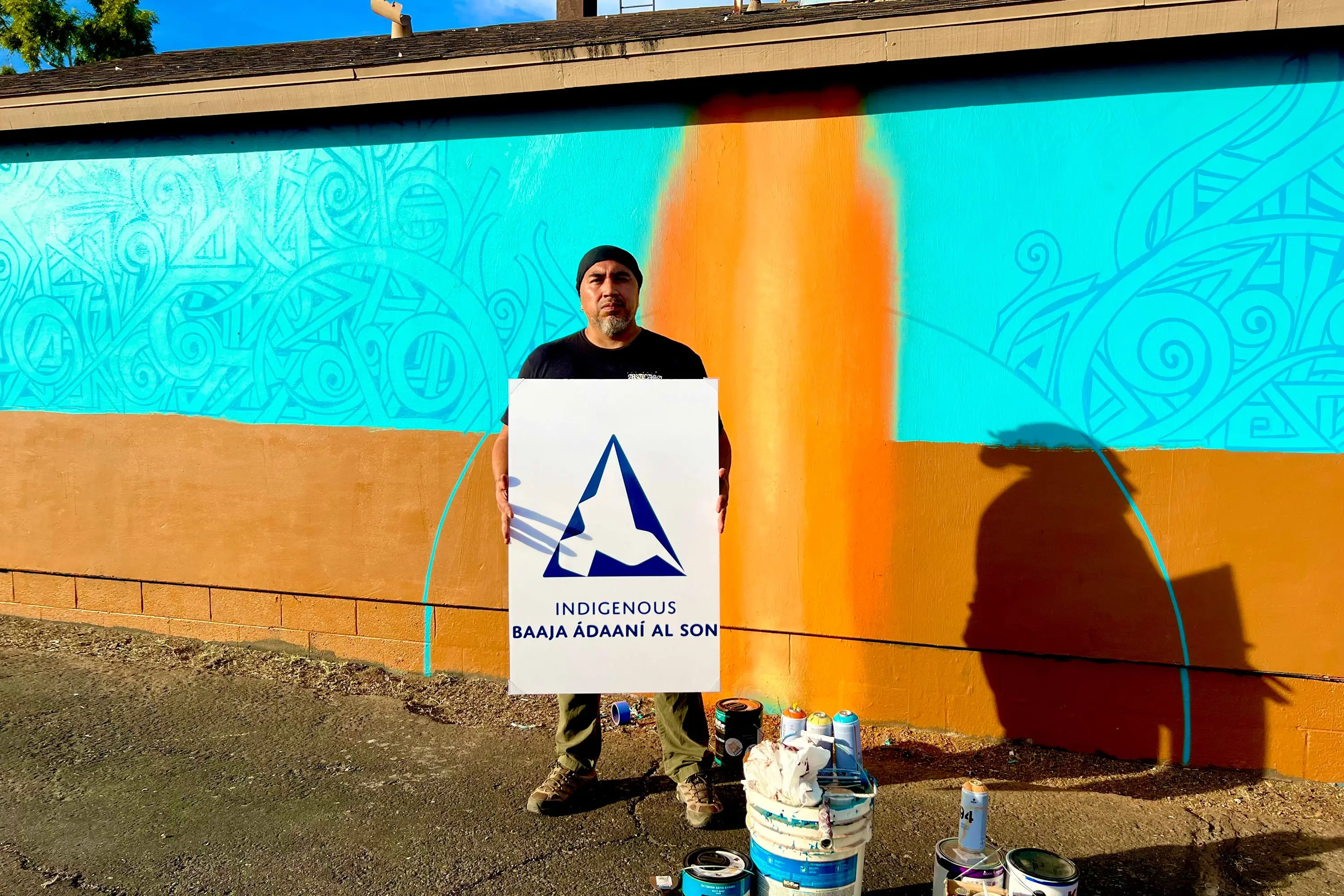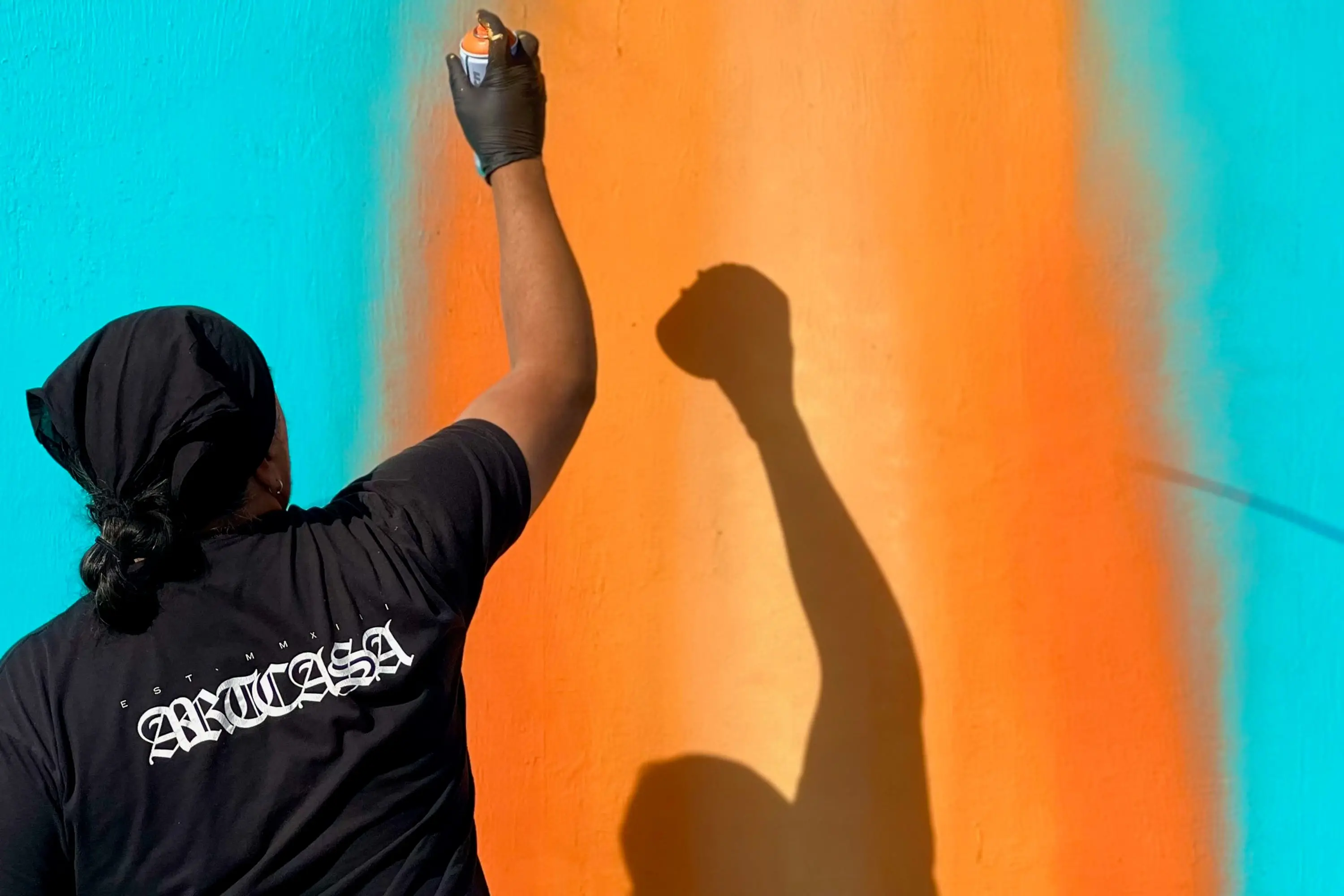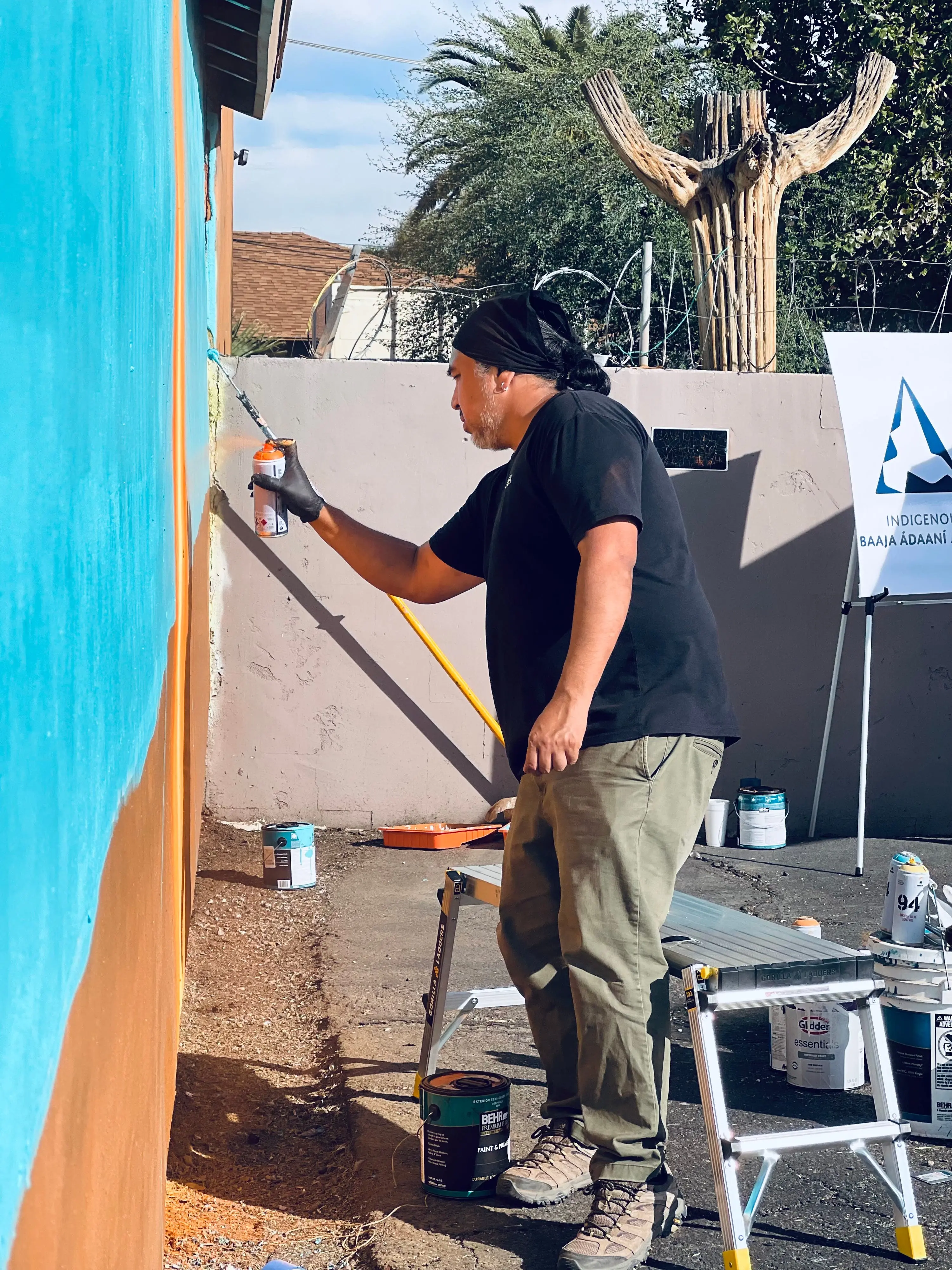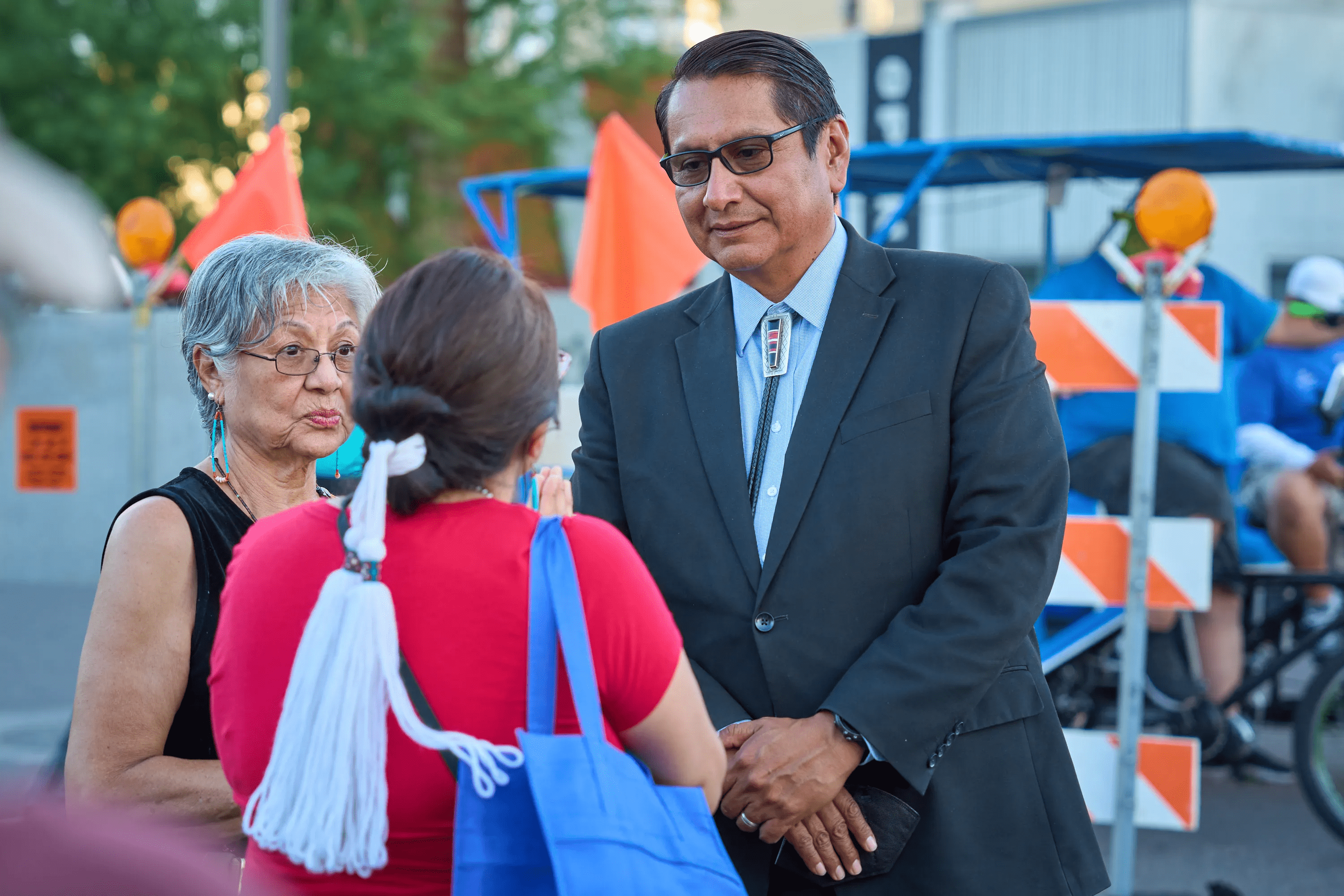
Thomas “Breeze” Marcus’s new mural on the side of the famous Fry Bread House in central Phoenix draws a parallel between part of his tribe’s creation story and the power of voting.

As a nonprofit journalism organization, we depend on your support to fund critical stories in local U.S. newsrooms. Donate any amount today to become a Pulitzer Center Champion and receive exclusive benefits!
An enrolled member of the Tohono O'odham tribe who was raised on the Salt River Pima-Maricopa Indian Community, Marcus has created about a dozen murals throughout Phoenix. But the new mural he began painting on Monday will hold a special meaning.
“Most of the work that I do ties with oral traditional story or something to do with current day situation,” said Marcus. “This piece will be an interpretation of one of our creation stories of how there was a big change amongst the people. Even though it is not necessarily in line with the form of voting and making a change, but it's still making a change.”
Marcus will spend Election Day working on the mural, hoping to finish it on Wednesday.

The mural is about the Man in the Maze, who goes underground because the people above had become different from the way he created them. The people above had become greedy and were abusing their power, so the Man in the Maze went underground and brought back up other O’odham people to rise up and take their power back.
“They make the change in society that is necessary by removing those leaders,” said Marcus. “That’s the nice way of putting it. But basically it was a revolt and a war against the leadership of those people who were in power and it was about restoring balance to the land and the communities.”
Connecting the creation story with voting
Native voting advocates have found creative ways to get Indigenous voters to cast their ballots in the Arizona elections and Marcus’s new mural is no exception. Looking to use his tribe’s traditional stories and teachings to depict a pivotal moment in his people’s creation, he said, is symbolic with what is at stake for Arizona tribes this election cycle.
Eric Descheenie, executive director of Indigenous Baaja Ádaaní Al Son, a statewide tribal political organization, was at the Fry Bread House to meet Marcus, who was creating the mural at the request of the organization.
“We being Indigenous Baaja Ádaaní Al Son are pointing members of our Native communities to the process of mural art work,” said Descheenie. “And how we use imagination, creativity and genuine love for our people, in contemporary ways of influencing change and in this case through voting.”
He explained that voting has its limitations, but the practical effect outweighs the limits, making the democratic process of voting important. Descheenie said the fact that Marcus's mural is rooted in the artist’s peoples’ creation story with a specific meaning behind it reinvigorates the possibility of what Native voters can do by casting their votes.
“It taps into the potential of us as Indigenous people in conceiving and advocating for a society that is rooted in goodness on our terms,” said Descheenie. “While at the same time saying ‘OK, voting is one of several things we can do that keeps us safe.’ And what I mean in terms of safety, I'm talking about a woman’s right to choose.”
Descheenie is concerned about the representatives that will be sitting across the table from Native leaders and citizens, because they will be taking on tribal issues whether they understand the issues or not.
“When it comes to institutional wherewithal of who we have to sit across the table,” said Descheenie, “at a minimum we would like some decent people to talk with. There are people on the ballot who are not decent and that's a big deal across the board on various issues.”
Fry Bread House welcomed the mural project
Across from the Fry Bread House is a billboard that reads “Mark Kelly = Open Borders.” Descheenie noted that the family that owns the Fry Bread House is Tohono O'odham, similar to Marcus, and the land Phoenix sits on is the ancestral land of the Akimel O’odham and Pee Posh Indian communities.
“There's a billboard over there that talks about open borders, but that damn border is offensive to O’odham people,” said Descheenie. “I love that you have a myopic billboard, but over here you are going to be talking about something that is fundamentally different, and inserting our truths as Native people but also very specific to O’odham people.”

Jennifer Miller’s parents founded the Fry Bread House in 1992. She has fond memories of her parents being very active when it came to elections and voting. Both volunteered as pollsters throughout their life. She said they were honored when asked if they would allow the Fry Bread House to be the canvas for Marcus’s art.
“My parents believed really strongly in the democratic voting process,” said Miller. “They worked the polls. My dad was always engaged in politics. He was a Presbyterian minister for Central Presbyterian Church. He was always involved talking with candidates. I grew up with a sandwich board along with him at the polls handing out pamphlets.”
This midterm election has been seen as one of the most contentious elections, especially in Arizona, where the rest of the country is keeping an eye on the governor's race. The election has been fraught with election denying candidates, only one of the issues that have non-Native voters concerned.
But when it comes to Native issues in Arizona, activists say candidates aren’t as passionate in discussing how they will work with tribes as they are to discuss abortion rights, the border, or whether Donald Trump lost the 2020 election. Oftentimes, Native issues have been swept under the rug, the activists say, but Native voters know the power of their vote after they helped President Joe Biden win Arizona in 2020.
“Every election is important, but this election is more important because it seems like there’s more division in the country, whether that is true or not, but it certainly feels like it,” said Miller. “I think these elections are going to continue to be really important and there is a lot of conversation and debate on a variety of different topics. Unless we come forward to vote, we are not going to have a voice. There are a lot of decisions and issues that will impact Indian Country and we need to be able to have a say in that. We have our voice muted when we don't vote.”
The art and humor used to appeal to Native voters is a creative and distinctive way to get Native voters registered and out to vote, and Marcus’s mural is one example of that.
“Native people are just by nature very creative and very poetic with the way we do things,” said Marcus. “We can take the simplest thing and make something out of nothing. So why not apply that to bigger scenarios in contemporary life. It shows the humanity in us, and the creativity to shine and really be present in those situations.”







